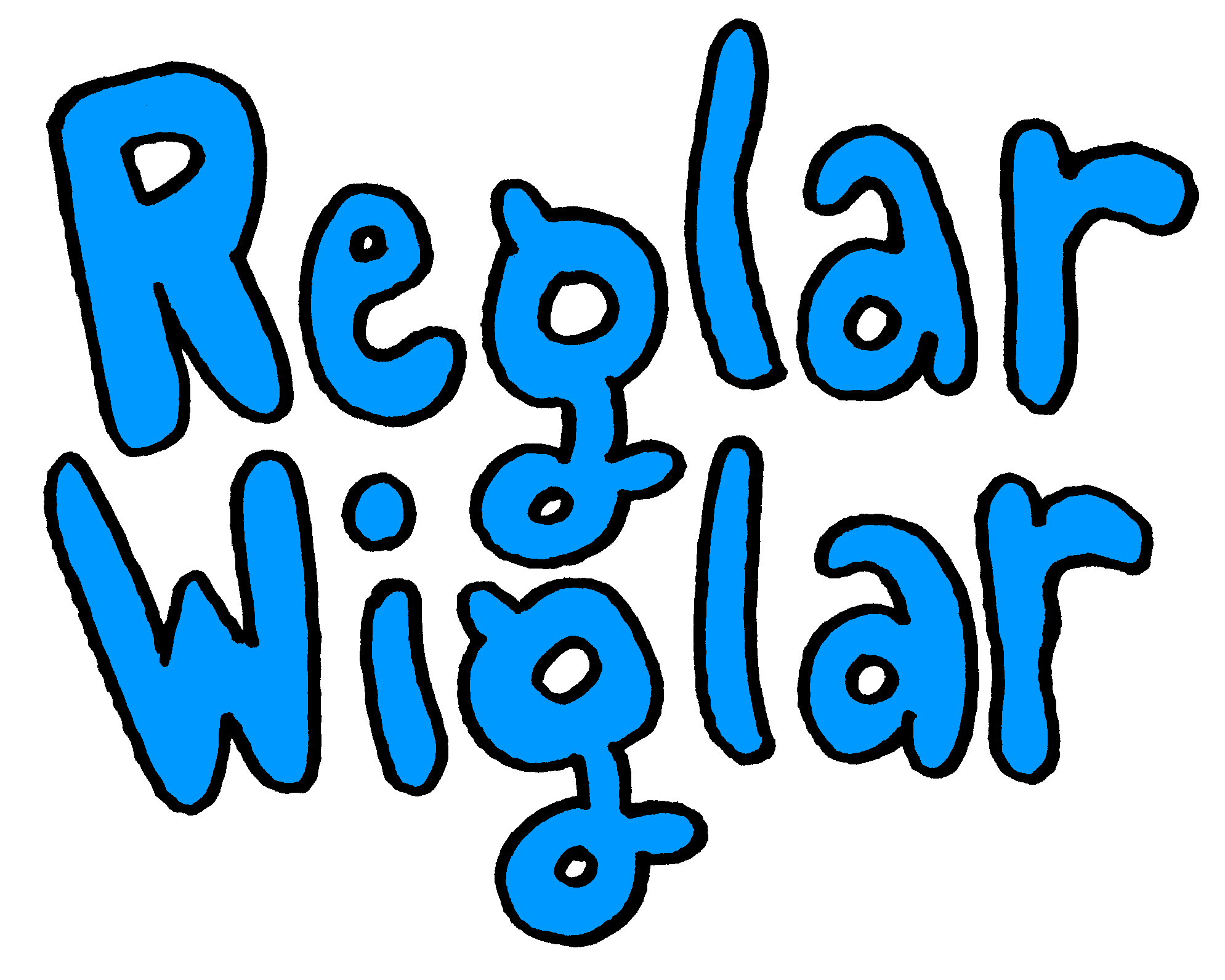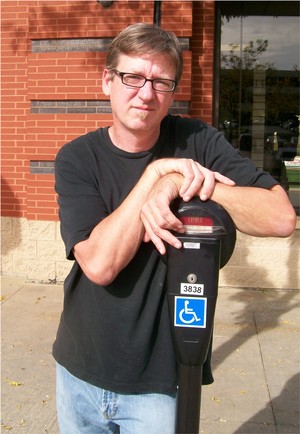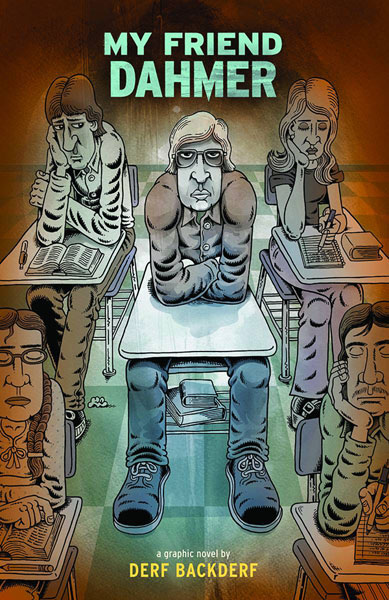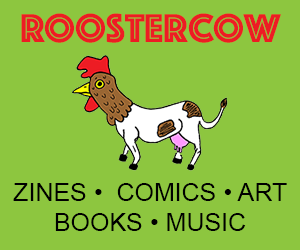 
  
Jeffrey Dahmer's friend
Derf Backderf
Published July 31, 2012

Derf Backderf has been a prime mover in the alternative comics universe since 1990. His ubiquitous strip "The City" has been logged into my subconscious thousands of times since then, but I wasn't aware of his work in graphic novels until a friend of mine gave me a copy of Derf's recent book about his high school friend, Jeffrey Dahmer.
I found My Friend Dahmer to be a well-researched, well-drawn, well-written story, in other words, a great graphic novel. Apparently, I am not alone in this assessment as the rights to a film version of the book were recently picked up, as reported in the Hollywood Reporter in July.
Not to be outscooped, Reglar Wiglar Magazine decided to interview Mr. Backderf on the state of the weekly strip, graphic novels and his experiences writing My Friend Dahmer.
You started drawing comics at a very young age. What were your early influences as a kid growing up in Ohio in the 60s and 70s?
The earliest lasting influence was Mad Magazine, just like every other cartoonist who grew up in the 50s, 60s and 70s. I especially liked Don Martin. Still do! Ed "Big Daddy" Roth was another favorite. His stuff was everywhere when I was a kid. I got ahold of some Robert Crumb stuff WAY earlier than I should have, like around ten or eleven, and that left a big impression, too. It wasn't the x-rated stuff, and I didn't get the drug references, but I dug the way he drew.

You sold your first drawing for two bucks to a 6th grade classmate. Could you describe that drawing to us and what lesson you may have learned from that transaction?
It was a nude portrait of our 6th grade teacher! I couldn't stand the woman, and she was no fan of mine either. She was constantly chewing me out for drawing in class, instead of "paying attention." She'd take away my paper, so I'd draw on the desk. She'd yell at me about drawing on the desk, so I'd draw on my pants! This battle went on the whole year. But she was young, right out of college, and very attractive and quite voluptuous, so all of the young horndogs drooled over her. The horniest of these commissioned the drawing, for masturbatory purposes one must assume.
Were you actively involved in art in high school?
Oh sure. I plastered that school with art. Posters, cartoons for the newspaper and yearbook, flyers, whatever. Problem was, the art teachers didn't give me credit for any of this stuff. It wasn't "real" art, painting and pots and such, so it didn't count in their eyes. In fact, I got a 'D' in art my senior year because of this!

What’s the origin of the name Backderf anyway?
Originally, it was a Swiss name, Bartof. Then it got butchered here in the States over a 50-year period or so and eventually evolved into Backderf. I have no idea why this happened. Pretty awful name, but I got a good nom de plume out of it.
So you dropped out of art school in Pittsburgh, moved back to your hometown in Ohio and worked on a garbage truck for a year. Any lessons learned from art school or the garbage truck that you’ve taken with you and applied to the rest of your life?
Art School? Nothing. Total waste of time with nothing of value learned at all, other than learning art school was a complete waste of time, that is. In fact, it set me back. because all the art teachers lectured me on what a lousy career comics were. I wanted to be a comics creator since I was five years old, and all these geezer hacks thought I was nuts. The guy who taught cartooning, whose class had actually lured me to the school in the first place, scolded me about this every day for the entire quarter. I guess he saw I had potential and wanted to "save me" from a career mistake. He recommended I get a job with a greeting card company. THAT was a great career, in his mind. Even the school president pulled me aside one day and gave me the same spiel! I was totally devastated. So much so, I just packed it in and returned home.
I was lost. I had no idea what I was going to do next. That's when the garbage truck saved me. Hanging off the back of a garbage truck for a year will bring your life into focus, let me tell you. I knew I had to get my ass back to school and do what I wanted to do, or I'd be riding on that fucking truck for the rest of my life! To hell with what old geezers had to say about my choices! I still have a picture of the truck on the wall above my board, as a motivator. Garbage made a man out of me.
When I eventually went back to school, to Ohio State, I didn't major in art, so soured was I by art school, I majored in journalism! I didn't take a single art class my entire time there. I was always a good writer, so this isn't as radical a detour as it sounds. In fact, they eventually gave me a journalism scholarship. And my major gave me an "in" at the school paper The Lantern. For three plus years I filled that paper with cartoons and fell in love with the newspaper comics genre. This was far better than art school, because I was getting published as I was learning my craft. That could be rough, because when I failed, which was regularly, I flopped in front of 35,000 readers! But this is where I learned to meet deadlines and how to produce under pressure. The cartoons absolutely sucked, but it was a fabulous experience.

Your early comics look like they would have been perfectly at home in the pages of Raw Magazine, which stopped publishing pretty much when you started to get serious. Was Raw an influence, or maybe I should ask, what was influencing your brain in the late 80s/early 90s?
Ya know, I totally stopped reading comics in the 80s. Just went cold turkey. I didn't want to be influenced by what anyone else was doing. Sounds extreme, but it worked for me. My influences came from what I saw around me. The urban landscape of Cleveland, the art coming out of the counter-culture, the energy of the time. In a way, it was bad, because I wasn't involved in the comics community at all. I was a total outsider. But I believe it's the reason I developed a pretty unique style.
“The City” started in the, now defunct, Cleveland Edition, but was soon published in alternative newspapers all over the country, how did that develop? How did one get a weekly strip published back in the day?
Well, in 1989 I quit my full-time job at the Cleveland daily, The Plain Dealer, and holed up in my studio for a year. For the previous six years, since I graduated from college, I'd been toiling as a staff cartoonist at a couple daily papers—political cartoons, sports cartoons, caricatures, that sort of thing. I was an art director at the PD, too, mainly because I was a young hotshot on the newfangled Mac. Big papers from all over the country were contacting me and trying to lure me away. But I was creatively frustrated and sick of the constraints of the mainstream press. I wanted to make comics, without some middle-aged square editor telling me what I could and couldn't draw. I just decided it was now or never, so I walked away from a very well-paying job at a major metro. Torpedoed my art director career. Over the next year, I made tons of freeform comics and filled sketchbooks, all inspired by these wild comics I saw in The Edition.
After I had worked out what I wanted to do, I just made Xerox copies of a dozen strips and mailed them to the owner-editor of The Edition, guy named Bill Gunlocke, who was one of those marvelous alt-press fellows who was smart and quirky and open to anything. Guys like him have mostly been driven out of the biz by corporate overlords over the past decade, unfortunately, which explains why those papers have all become largely irrelevant. He called me right away and the strip debuted in the next issue. It was an immediate hit. That was a big thrill, to have at last hit the right chord. People were talking about "The City" all over town. It was a great period. Very satisfying.
And after a year or so, I started sending xeroxed packages to other weekly papers. I'd send out three or four mailings a year and usually pick up three or four papers each time. Steadily over ten years I built a client list. Topped out at 75 papers or so. Matt Groening and Tom Tomorrow both had a lot more papers, but there were four or five of us bunched up behind them. I made a modest living at it, doing what I wanted, how I wanted. It was a gas.
During that alternative paper heyday, "underground" comics were given a weekly forum—The Chicago Reader ran more than anybody—but even so, there weren’t that many, why do you think “The City” appealed to that readership at that time?
I just managed to plug into the Zeitgeist. To quote Joe Strummer, I had "the right shit, in the right place at the right time." A lot of guys were doing politics, like Tom Tomorrow, or wonderful absurdist stuff like Charles Burns' "Big Baby" or David Lynch's "The Angriest Dog in the World" or Doug Allen's "Steven", but I noticed no one was specifically writing about city-dwelling twentysomethings like me at the time. Since that was the target audience of these weekly rags, I figured there'd be interest in something like that. The title "The City" drove that home. And I was right, there was interest. I'd also like to think it had appeal because it was a pretty good strip! Hopefully still is.

How many papers still carry “The City”?
It's in 15 or so, including the daily paper here in Cleveland, my home base. Never thought THAT would happen! The editors at the PD were pretty pissed at me when I quit and blackballed me from freelancing for them. I retaliated with regular potshots at the PD in cartoons for the local weeklies, which cheesed them off even more. But all those editors are long gone and all is forgiven. I've come full circle, I guess. There's no future in newspaper comic strips, of course. It's the end of days for newspapers.
Is the state of alternative papers, and newspapers in general, something you lament or have you made the transition to digital?
I've made the transition to graphic novels is what I've done! This is a plan that I concocted ten years ago. I saw what was coming. Once weekly papers lost their classifieds and personals to the Internet, which was not only the financial lifeblood of the papers but one of the big reasons, along with the comics, people read the things in the first place, I knew the jig was up. Because those pages of grey agate type were where the comics lived. And sure enough, editors started dumping comics in short order, in favor of porn and hooker ads. They didn't get that people picked up their rags for the comics. They still don't get it. I probably should have retired the strip five years ago, to be honest. It's hard to walk away.
I had so much fun doing my first book Trashed, which came out in 2002, that I decided that was what I wanted to do moving forward. Unfortunately, right after that book was released, I got whacked by cancer. So I lost about 5 years dealing with that. I beat it, but it took a lot out of me and there was no way I was going to tackle something as big as a graphic novel during this period. So the schedule got pushed back. I still managed to produce "The City", and was quite grateful to have that routine, but I'd have two more graphic novels under my belt, if not for the cancer.
Digital publishing is just another way to get your work out there. I don't see it as a print vs. digital thing, as if people are set up in separate camps. What I've noticed is that the guys who gloated most about the superiority of digital-only comics, the self-proclaimed web pioneers who openly mocked established print cartoonists, were the ones who created the lamest dreck. They're now being supplanted by far superior web comics. The hopeful thing is, people are finally starting to figure out how to make money in digital comics, Kickstarter and paywalls and subscription services and that sort of thing.
Me, I've had a web presence since the mid-90s. Wizard World named "The City" one of the top webcomics last year, which cracked me up quite a bit, since I'm not trying very hard. But I post everything on my website and lots of people read it there. It's also carried on Universal Press' big comics site Gocomics.com. Additionally, I've experimented with different formats. I've posted several new chapters of Trashed on my site, just for fun and to play around with presentation. It's on sabbatical now, since I've been so busy with the book tour, but I hope to get back to it.
I heard Matt Groening speak at the Humanities Festival in Chicago a few years back and he compared doing a weekly strip to having a term paper due every week of your life. Is that true for you as well?
It is lately. I've had a lot of difficulty going back to comic strips after doing books. I'm like a Trappist monk bent over a parchment taking a year to draw one letter. I'd like to say I've just been in a funk, but it's been like this for awhile now and I can't seem to snap out of it. For years, it was a fairly free and easy process, a lot of fun making a strip each week. The drawing was loose and effortless. I dunno. I'm still coming up with good stuff, but it's like giving birth. Maybe I've just been at it too long. I don't have this problem with graphic novel pages. Must be a mental thing.
Are graphic novels easier/harder (despite the obvious difference in length) or do they both present an equal challenge for you?
They're a joy to make. They can be as long as I want. I can write and draw my ass off. It's a totally different creative process than making a strip, and a different kind of payoff. A graphic novel is its own self-contained world and I can make it be whatever I want it to be. And it has permanence. People save books, add them to their collection or display them on a bookshelf. Newspapers are tossed into a recycling bin right after they're read. The best you can hope for is someone clips out a strip and tacks it to their cubicle wall for a week or two. The downside is books take a long time to make, usually about two years from start to finish. With a strip you get that weekly buzz, which I love. I draw it and a few days– or a few hours!– later and it's out there.
Speaking of graphic novels, My Friend Dahmer was a long time in the making. You started this project, really in 1994 after Dahmer’s death in prison, and it was published in a few early forms previously. Was it worth the work and the wait?
I started it even earlier than that, actually, in 1991, just a few weeks after Dahmer's crimes came to light. I began jotting down notes and drawings in a sketchbook. I wasn't sure what I was going to do with it, since I wasn't even considering long-form comics at that point, but I recognized right away what an amazing story I had.
Then, yeah, it took a long time to figure out what I wanted to do with it and, more importantly, to acquire the skills I needed to make the book. I thought, in my arrogance, that the transition from strip to graphic novel would be easy. But those first Dahmer stories from 1995-97 were pretty rough to my eyes. That's why I did other books first, to develop those skills. It was a good move, because when I finally tackled My Friend Dahmer, I was at the peak of my abilities. I couldn't have done this book without first doing the two that came before.
And, yeah, judging from the acclaim and the sales, it was well worth the wait.
What was your research process like and which was harder, writing, researching or the actual drawing?
I started with my own papers and memories. This is a first-person account, after all, and I built from there. I interviewed dozens of people over a 15-year period: friends, classmates, neighbors, teachers, anyone I could think of. I didn't much trust the news accounts or any of the books that had been written. Most were rushed out after Dahmer's capture and trial and most were full of errors. So I re-reported everything, putting that journalism training to good use. I got copies of police reports and FBI files. I got transcripts of the many interviews Dahmer gave in prison to profilers and psychologists. I have a file cabinet stuffed with material.
The book has 20 pages of detailed footnotes in the back, listing the source material for every scene in the book, point by point in chronological order. This what I started with. As I found new stuff during my research, I amended the notes. I didn't work on it constantly over the years, but I did work on it regularly.
The hardest thing to collect was the photo reference. This was a craphole little town in an era well before digital cameras and camera phones. It was a pain in the ass to take pictures then, so no one really did. You had to mess with film and developing, and cameras were both shitty and expensive. No one recorded much of anything because who cared? Like the local shopping mall. I have a major scene set here and I had a bitch of a time finding photos. Who after all took pictures of the inside of a mall in 1977? So I spent years collecting the rare visual reference I needed to recreate this time and place. It paid off, because many have commented how richly detailed those scenes are.
I did so much research over such a long period of time when I finally sat down to write the book, I did it in a week. That's how clear the story was in my head. I simply took those footnotes, blocked them into three acts and the story was there.
The drawing was relatively easy. Just crank out pages one at a time, scene by scene. A year later, the book was done. I had fun with that.
You avoid Dahmer's life after graduation, including of course, the horrific crimes he committed. Did you ever consider including that aspect or was that just completely off the table for consideration?
I always knew I'd stop with graduation, because that's when our friendship ended. I never saw him again. I like surprising readers, and the big surprise in My Friend Dahmer is that it's not about his crimes at all. In fact there's really no violence to speak of in the book. It would have been a very different book had I gone further. My premise was that Dahmer is something of a tragic figure. But that only applies up until he kills. After that, he's a fiend. But the Jeff I knew, remember, had committed no crime. He's broken, he's horribly disturbed, he's missing chunks of his humanity, he's not particularly likable by the end, but he isn't a monster. Not yet.
I read on Wikipedia that you were immersed in punk rock in the 1980s, as any creative person with a brain was, please describe your particular experience?
My little hometown was situated halfway between Akron and Cleveland, and both had vibrant and hugely influential punk scenes. Everyone thinks punk rock bubbled out of New York City and London, but it came out of Rustbelt Ohio at the same time. My second book Punk Rock and Trailer Parks is all about this. It's fiction, but it's set in the Ohio punk scene.
Cleveland had sonic monsters like Rocket From the Tombs, the Electric Eels and the Styrenes, and later Pere Ubu and the Pagans. They were a little too extreme for me at the time, a 15-year-old farmboy rube. But in high school, me and a buddy ventured up periodically to the back-alley clubs in Cleveland to hear Pere Ubu. That was great fun. They used to have Pere Ubu Dance Parties at this club in an industrial area on the banks of the Cuyahoga River. It was this little joint with a bunch of punk mutants milling in front of it. Fog rolled off the river and the club was surrounded by smelt shops with sparks and fire flying out the doors. The black steel skeletons of massive bridges looming overhead. And Pere Ubu was so dissonant and strange. It was like a scene out of Blade Runner!
I was more into the Akron scene. It was more musical, with bands like Devo, the Cramps, the Dead Boys and a host of others. The main punk club was easy to find, right downtown, called The Bank. It was just that, an old bank that had closed and been converted into a music club. The vault was still on one wall... they kept the booze in there! One of the great punk clubs. Rubber City Punk is largely forgotten now, but it was huge in the day. I hung out at The Bank a lot during my year as a garbageman. Pretty fitting. What could be more punk?
But I moved to Columbus in 1979 to attend Ohio State, so it was often a long-distance love affair. Columbus had a lot of punks, but very little local scene. No bands worth mentioning. Luckily, all the touring acts made stops there, so I got to see all the great ones such as the Ramones, Talking Heads, The Damned, The Jam, Plasmatics, etc,, etc. It was fun, but I wish I hadn't been so young. I wasn't developed enough as an artist or cartoonist to contribute to the scene in any way. It's one of my big regrets.
What’s next for Derf Backderf?
More books, more comics. Work until you die!
Last question, you gonna finish that Polish Boy?
That's not part of my heart-healthy diet.
Read more comics artist interviews:
Jesse Reklaw
John Porcellino
Hans Rickheit
Mimi Pond
Tom Neely
Ed Piskor
Andrew Maclean
Jef Czekaj
Jeffrey Brown
Box Brown
Simon Gane
Corinne Halbert
Ben Snakepit
|